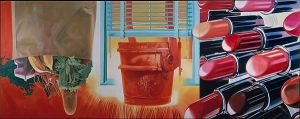
James Rosenquist, House of Fire, 1981, oil on canvas, 78 inches x 17 feet, 6 inches. Met Museum of Art
Pop Art and Minimalism
Pop art and Minimalism follow Abstract Expressionism in the 1950s and ‘60s. Both styles develop as a reaction against the subjective intensity and physical aspects associated with Abstract Expressionism. Pop art responds by celebrating recognizable subject matter drawn from the everyday, the commercial, and the commonplace and rejecting the emphasis on abstraction. Minimalism responds by focusing on the formal aspects of the artwork, rejecting the idea of the individual gesture of the artist and the subjective expressionistic focus of Abstract Expressionism in favor of establishing a different relationship between art, its viewer and the space both occupy.
Both styles push the language of modernism to its conclusion meaning that with them, the language of modern art has now been completely and successfully explored. With Pop art, we see the merging of the realms of art and popular culture, art and technology, and art and commercialism that began with the Impressionists and Post-Impressionists and that continued to define modern art in different ways over the 20th Century. With Minimalism, we see the final explorations of the possibilities of strict geometric and non-representational abstraction that here harnesses the space beyond the gallery’s wall or sculptural pedestal to re-define the boundaries of art beyond the two and three-dimensional.
What follows these two styles in the 1970s is called Post-Modern because it comes after modernism and uses the visual languages of modernism as seen in the various art styles we have studied but in different ways or for different reasons.
Pop Art
Read introductory essay about Pop art on artstory.org – LINK: http://www.theartstory.org/movement-pop-art.htm
And Pop Art essay on Khan Academy: LINK:
https://www.khanacademy.org/humanities/art-1010/pop/a/pop-art
Then, on menu on far left, watch two videos and read one essay about the three artworks by Andy Warhol in the vertical menu after this introduction.
Video: Why is this art? Warhol’s Campbell Soup Cans – LINK: https://www.khanacademy.org/humanities/art-1010/pop/v/andy-warhol-campbell-s-soup-cans-why-is-this-art
Video: Warhol’s Gold Marilyn Monroe – LINK: https://www.khanacademy.org/humanities/art-1010/pop/v/warhol-gold-marilyn-monroe-1962
Read essay: Warhol’s Marilyn Diptych – LINK: https://www.khanacademy.org/humanities/art-1010/pop/a/warhol-marilyn-diptych
Minimalism
Read essay about Minimalism on artstory.org – LINK:
http://www.theartstory.org/movement-minimalism.htm
And, click on ‘Minimalism Artworks in Focus’ inside blue text box and read about the first five artworks through Donald Judd’s Untitled.
And, read Minimalism essay on Khan Academy: LINK: https://www.khanacademy.org/humanities/art-history/art-1010/minimalism-earthworks/a/an-introduction-to-minimalism
Read and watch any videos in menu on far left of your choice.
Read essay about Richard Serra’s Tilted Arc – a large public sculpture – LINK: https://www.khanacademy.org/humanities/art-history/art-1010/minimalism-earthworks/a/richard-serra-tilted-arc
And, about Maya Lin’s Vietnam Veterans Memorial on the national mall in Washington DC as a public monument – LINK: https://www.khanacademy.org/humanities/art-history/art-1010/minimalism-earthworks/v/mayalin-vietnamvetmem
WRITING ASSIGNMENT:
Write two separate short summaries or bullet points about Pop art and about Minimalism.
In each, include an overview of the type of visual characteristics and subject matter in this style. Explain in your own words how this style relates to or reacts against Abstract Expressionism in both formal characteristics and in subject matter. Also, explain how it relates to the viewer in a unique and/or different ways.
For class next week – summary of the 1 required thing to do:
- Read and take notes on Pop art and Minimalism, completing the two note-taking summaries from the above instructions.


